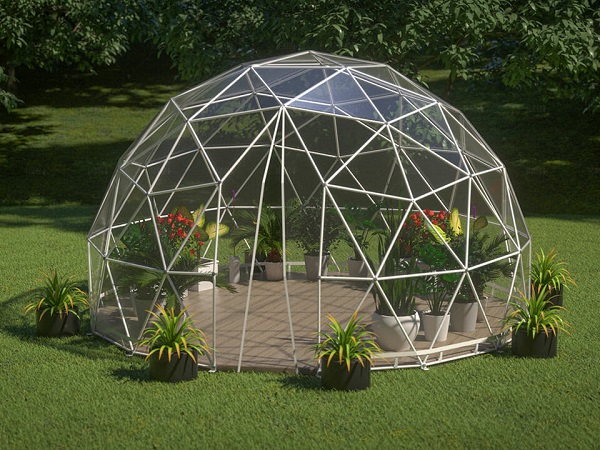The geodesic greenhouse is a type of greenhouse that features a dome-shaped structure made up of interconnected triangles. This design allows for maximum strength and stability while using a minimal amount of material. The history of the geodesic greenhouse can be traced back to the mid-20th century.

The concept of the geodesic dome was developed by the American inventor, architect, and futurist R. Buckminster Fuller. In the late 1940s, Fuller became interested in using geodesic domes for housing and other structures. He believed that these domes could be used to create affordable, energy-efficient, and environmentally friendly buildings.
In the 1950s and 60s, geodesic domes became increasingly popular as a form of alternative architecture. Many builders and designers began experimenting with geodesic structures, including greenhouses. The first geodesic greenhouse is believed to have been built in the 1960s by a horticulturist named Ted Geier. Geier designed his greenhouse using a geodesic dome structure made from PVC pipe and plastic sheeting. This innovative design allowed for maximum sunlight exposure and efficient use of space, making it ideal for growing a wide variety of plants.
Since then, the geodesic greenhouse has become a popular choice among gardeners and horticulturists who value its strength, durability, and energy efficiency. Today, geodesic greenhouses are available in a range of sizes and materials, from small backyard structures to large commercial facilities. They continue to be a symbol of innovative and sustainable design.
5 Advantages of Geodesic Greenhouses
Strength and Durability
The geodesic dome design is incredibly strong and can withstand high winds, heavy snow loads, and other extreme weather conditions. This means that geodesic greenhouses require less maintenance and are less likely to suffer damage or collapse.
Efficient use of Materials
Geodesic greenhouses use a minimal amount of material compared to traditional greenhouse designs, making them a more cost-effective option. This also means that they have a smaller environmental footprint and can be more sustainable.
Energy Efficiency
Because of their dome shape, geodesic greenhouses can trap heat more effectively than traditional greenhouses. This means that they require less heating in cold weather and less cooling in hot weather, which can result in significant energy savings.
Maximum Sunlight Exposure
The triangular shape of the geodesic dome allows for maximum sunlight exposure throughout the day, which is ideal for growing plants. This also means that plants can be grown in areas with limited sunlight.
Versatility
Geodesic greenhouses can be built in a range of sizes and shapes, making them suitable for a variety of applications. They can be used for everything from small backyard gardens to large commercial facilities.
5 Disadvantages of Geodesic Greenhouses
Complexity of Construction
The unique shape of the geodesic dome can make construction more complicated than traditional greenhouse designs. This can require more time and expertise to build, which can increase costs.
Limited Headroom
The dome shape of geodesic greenhouses means that headroom is limited around the edges of the structure. This can make it more difficult to work around the perimeter of the greenhouse and may require some adjustments in growing methods.
Limited Layout Options
Because of the unique shape of the geodesic dome, the layout of plants and equipment inside the greenhouse may be more limited than in a traditional rectangular greenhouse.
Potential for Leaks
Geodesic greenhouses often have more seams and joints than traditional greenhouse designs, which can increase the potential for leaks over time.
Cost
While geodesic greenhouses can be more cost-effective in terms of materials, the complexity of the design can make them more expensive to construct than traditional greenhouses.
6 Fun Facts About Geodesic Greenhouses
The term “geodesic” comes from the Greek word “geo,” which means “earth,” and “desic,” which means “dividing.” The geodesic dome is a type of structure that divides the earth’s surface into a series of interconnected triangles.
The geodesic dome was invented by R. Buckminster Fuller in the 1940s. Fuller was a scientist, inventor, and visionary who believed that the geodesic dome could revolutionize architecture and solve many of the world’s problems.
Geodesic greenhouses are often used for growing plants that require high humidity, such as tropical fruits, orchids, and ferns. The dome shape of the greenhouse helps to maintain a high level of humidity, which is essential for these types of plants.
Some geodesic greenhouses are designed to be portable and can be easily moved from one location to another. This can be particularly useful for farmers and gardeners who need to move their greenhouse from one plot of land to another.
Geodesic greenhouses can be used to grow plants in a wide range of climates and environments, from deserts to the Arctic. The dome shape helps to trap heat and moisture, making it possible to grow plants in areas where they would not normally thrive.
The largest geodesic greenhouse in the world is the Eden Project in Cornwall, England. This massive structure covers an area of 15 acres and contains thousands of plants from around the world.
Related Articles & Free Email Newsletter Sign Up
Hothouse or Greenhouse: Which One is Right for You?
How Glass Works in Greenhouses




Comment here